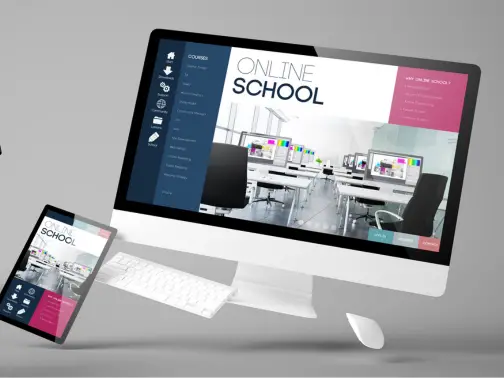Contents
Toggle
Meet David De’ Ath, founder, editor, and writer at Wonderful World English. With his extensive background as an English teacher, David provides valuable insights and practical tips on ESL for students and teachers alike.
Teaching a language online offers a world of opportunity not just for educators but also for students across the globe seeking to expand their linguistic capabilities.
As the digital landscape continues to evolve, the demand for online language education increases, allowing teachers to reach an ever-growing audience.
The convenience and flexibility of this mode of education appeal to a wide range of learners, making it an exciting and lucrative venture for language professionals.
To effectively teach a language online, you must determine the language of choice and understand your target audience. Then, you must build engaging lesson plans and choose reliable online software. Include relevant materials to complement your lesson plans and create an online presence via a website or social media.
To excel in online language teaching, instructors must embrace a combination of effective teaching techniques, savvy marketing strategies, and a deep understanding of the digital tools available.
It starts with a structured approach to lesson planning and curriculum design that takes into account the unique challenges and benefits of the digital classroom.
Furthermore, teachers must market their services effectively to stand out in a competitive marketplace and leverage the best practices in online education to ensure a successful learning experience.
Key Takeaways
- Proper preparation enhances the effectiveness of online language teaching.
- Marketing is crucial for attracting and retaining language students online.
- Applying best practices in teaching is key to student success in language learning.

Getting Started as an Online Language Teacher
Embarking on a journey to teach languages online requires some preparation.
Aspiring educators need to get acquainted with the essentials, create an appropriate workspace, and acquire key equipment.
Understanding the Basics
One must first understand the foundational aspects of online language instruction.
Teachers should possess a firm grasp of language teaching methodologies and be able to adapt these techniques to the digital space.
Experience in teaching, whether in-person or online, greatly supports educators in developing effective lesson plans.
Selecting a suitable online teaching platform is crucial, as it serves as the virtual classroom where instruction takes place.
Setting Up Your Teaching Environment
To create an engaging learning space, educators should ensure they have a strong internet connection to facilitate smooth video calls.
The workspace should be quiet, free from distractions, and have a clean, professional background.
Proper lighting is also important to maintain a clear visual connection with students.
Acquiring the Necessary Equipment
The right tools are vital to delivering lessons effectively:
- Laptop/Computer: A high-performance laptop or desktop computer is essential.
- Microphone: A quality microphone is necessary for clear audio communication.
- Webcam: A high-definition webcam allows for crisp video quality, making interactions more personal.
- Extras: Having a backup internet connection and power source can help reduce disruptions during lessons.

Creating Engaging Lesson Plans
An essential element of teaching languages online is crafting lesson plans that are not only educational but also captivating for students.
This requires thoughtful design and the integration of various multimedia resources.
Designing Effective Lesson Structures
A well-structured lesson plan is pivotal to the success of any language-learning session.
It begins with clear objectives, outlining what the student should be able to do by the end of the lesson.
This is presented in the table below:
| Objectives | Description |
|---|---|
| Target Vocabulary | List new words and phrases to be learned. |
| Grammar Focus | Identify the grammatical structures for the session. |
| Cultural Points | Include relevant cultural insights related to the language. |
| Skills Practice | Specify which language skills (reading, writing, speaking, listening) will be addressed. |
Next, lessons should progress logically, starting from warm-up activities, moving to core content delivery, and culminating in practical application and assessment tasks.
Here, variety is key to keeping students engaged.
One might alternate between individual work, peer discussions, and interactive group activities to cater to different learning styles.
Incorporating Multimedia Resources
Multimedia resources play a critical role in enhancing the language learning experience.
By incorporating videos, teachers can provide visual and auditory stimuli that make language patterns more memorable.
Videos offer context through body language, facial expressions, and cultural settings that enrich the learning process.
Similarly, audio resources such as podcasts or recordings of native speakers contribute to the development of listening skills and proper pronunciation.
These can be included as part of exercises where students listen and then answer comprehension questions or mimic the speech to practice pronunciation.
Content such as interactive quizzes, flashcards, and digital games leverages technology for engagement and makes reviewing language concepts more enjoyable.
To facilitate different aspects of language learning, a table of multimedia resources can be created:
| Resource Type | Purpose | Example Activity |
|---|---|---|
| Video Clips | Visual context and listening practice | Watch a short film and answer questions. |
| Audio Recordings | Listening and pronunciation | Listen to a dialogue and repeat phrases. |
| Interactive Tasks | Application and review | Use digital flashcards to reinforce vocabulary retention. |

Marketing Your Language Tutoring Services
Marketing is a crucial step in the journey of an online language tutor looking to attract language learners from around the world.
Effective marketing strategies not only showcase their proficiency as native speakers but also build a trustworthy brand that resonates with potential students.
Utilizing Social Media
An online language tutor must leverage social media platforms to connect with a broader audience.
They can share bite-sized lessons, language learning tips, and cultural insights that highlight their teaching style.
By using targeted hashtags and engaging with language learning communities, tutors increase their visibility.
Platforms like Instagram and Facebook enable them to post regular content that can spark the interest of potential students.
Building a Strong Online Presence
Creating a professional website with an informative blog can significantly bolster a tutor’s online presence.
The blog should include articles on language learning challenges, tips, and the benefits of learning a new language with a native speaker.
This demonstrates the tutor’s expertise and improves search engine rankings, making it easier for language learners to find them.
Their website should clearly display the teaching services, certifications, and language proficiency levels they cater to.
Gathering Student Reviews and Testimonials
Positive reviews and testimonials are powerful tools for tutors to establish credibility.
They should encourage satisfied students to leave feedback on their website or on the tutoring platforms they use.
Sharing success stories or video testimonials can significantly influence prospective students’ decisions, as they provide tangible proof of the tutor’s ability to facilitate language acquisition effectively.
Detailed reviews can also underscore a tutor’s unique teaching approach, attracting students who prefer customized learning experiences, as highlighted in Heylama.

Teaching Techniques and Best Practices
Effective online language teaching combines a strategic approach to nurturing language skills, adapting teaching methods to accommodate various learning styles, and providing constructive feedback.
These practices require a skillful blend of technical teaching skills with patience and motivational techniques, ensuring learners can thrive in a virtual environment.
Nurturing Language Skills
Teachers must prioritize learners’ ability to communicate clearly in the language being taught.
Emphasis on pronunciation and regular conversation practice are vital.
Using tools like online whiteboards to visualize mouth positions can help improve pronunciation, while prompt-driven chat sessions enhance conversational ability.
For example, assigning tasks centered around daily scenarios can simulate real-life conversations.
Adapting to Different Learning Styles
Educators should recognize and adapt to the diverse learning styles of their students.
A flexible schedule may accommodate learners with varying availability, ensuring everyone has an equal opportunity to participate.
Visual aids for spatial learners, interactive activities for kinesthetic learners, and discussion forums for verbal learners demonstrate a teaching approach that respects individual learning preferences.
If you’re curious about how you can be more effective in teaching subjects like reading online, check out the guide below for some great insights!
Related Article: How to Teach Reading Online – Teacher’s Guide
Providing Constructive Feedback
Constructive feedback is essential for language development.
Teachers should strive for a balance between encouragement and constructive criticism to maintain student motivation.
Feedback should be timely and specific—highlighting strengths, areas for improvement, and actionable steps.
Utilizing video tools can allow real-time corrections during speaking exercises, reinforcing the learning process.

Advanced Strategies for Online Language Teaching
To excel in online language teaching, educators must leverage powerful technology and master career management skills.
These advanced strategies can help ensure an impactful e-learning experience and optimize one’s earning potential.
Leveraging Technology and Online Resources
Teachers have an array of digital tools at their disposal to enhance the online classroom experience.
Incorporating interactive software that provides unlimited access to language learning resources can be a game-changer.
Platforms like Rosetta Stone and Duolingo offer immersive language practice, while tools like Quizlet allow teachers to create custom flashcards and games.
Using reliable video conferencing tools, such as Zoom or Skype, is essential for video lessons and real-time interactions.
Assignments can be easily distributed and collected through Learning Management Systems (LMS) like Google Classroom or Moodle.
These systems streamline the assignment workflow and provide a central hub for feedback and grades.
Teachers should curate a mix of multimedia resources—such as podcasts, videos, and articles—from the best websites tailored to language learning, making content engaging and contextually rich.
As we can see, online learning comes with its own set of challenges that don’t exist in face-to-face learning.
But does that mean face-to-face learning is better than online learning?
Find out the answer and so much more by clicking the link below!
Related Article: Is Online Learning as Good as Face-to-Face Learning?
Managing Your Online Teaching Career
Successful online language teachers must also be shrewd managers of their teaching careers.
Setting one’s own rates commensurate with experience and demand is crucial for maximizing earning potential.
Educators can offer their services on several tutoring platforms, like VIPKid or italki.
There, they can teach on a flexible schedule that suits their lifestyle.
Educators should actively market themselves to thrive, showcasing their teaching style and success stories on professional social platforms like LinkedIn or their personal branded website.
Financial aspects, including invoicing and payments, can be managed through online services like PayPal or TransferWise.
This ensures seamless transactions with international students.
Teachers must keep abreast of the latest trends and demands in language teaching, continuously adapting their strategies and materials to meet the evolving needs of students.
If you are curious whether online teaching is a worthwhile career and the right path, check out the article below for some insights!
Related Article: Is Online Teaching a Good Career? – Teacher’s Answer

Conclusion
Teaching a language online can be rewarding and open a world of opportunities to teachers everywhere.
With a growing demand due to its affordability and convenience, now is a great time to start considering a career path in online language teaching!
Teachers should embrace the points made in this guide, from knowing their student’s needs to choosing the right software and including engaging and interactive activities and forms of media.
Building an online presence is key to establishing credibility and authority within the realm of online language teaching, and teachers should work to achieve this.
It may take time and effort, but the result will be worth it.
Online language teaching is an enriching venture and can touch the lives of countless wonderful learners around the world to help them build a better future for themselves!
We hope this guide has given you some valuable insights into the world of online language learning; you can reach out to us if you require any assistance or support.
Have a wonderful day!
Image Attribution: All images licensed via canva.com





